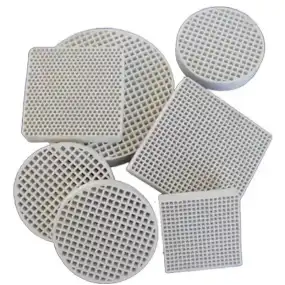
Knowledge
Iron Liquid Filtration Process (Part Two)

Section 1: Types of Filters
Commonly used filters
1. Glass fiber filter screen: Made from high-temperature resistant glass fiber cloth through special treatment, it has poor filtering effect but is inexpensive.
2. Straight hole filter: It has a good filtering effect, high cost performance, and is widely used.
3. Foam ceramic filter: It is made by coating ceramic slurry on a foam plastic skeleton and firing it. It has a good filtering effect and is widely used in refractory aggregates for filtering different metals. Zirconia is used for filtering cast steel; silicon carbide is
used for filtering cast iron and cast copper; corundum is used for filtering cast aluminum alloys.
4. Large casting silicon gel foam ceramic filter: The silicon gel foam ceramic filter is a newly emerged type of filter, which has better high-temperature performance than the conventional foam ceramic filter. It can be made in larger sizes and is suitable for filtering large cast steel and cast iron parts. It has a lower heat storage coefficient and a slower cooling rate for the initial metal liquid.
Section 2: Selection of Foam Ceramic Filters
I. Function
The working principle is to make the turbulent and agitated molten metal become stable, uniform and clean after passing through the honeycomb holes of the foam ceramic. The unique honeycomb structure can adsorb some small particles on its surface, removing impurities that cause surface problems of the product and reduce the strength of the casting, such as some non-metallic particles, slag, refractory material fragments, etc. The stable laminar flow of the molten metal better fills the mold, effectively removing non-metallic inclusions in the molten metal, improving the microstructure and mechanical properties of the casting, and producing high-quality standard castings, reducing the wear of tools during casting processing.
II. Features
1. The honeycomb structure can adsorb particles and filter out inclusions in the casting, transforming the turbulent flow of the molten metal into a stable laminar flow, allowing gas bubbles in the molten metal to escape, effectively reducing porosity in the casting, and minimizing turbulent flow during filling to reduce surface defects and significantly increase the casting yield.
2. The stabilized and purified molten metal enhances the casting's compressive sealing performance, increases its tensile strength and elongation, and improves surface finish.
3. It simplifies the design requirements of the casting system, shortens the length of the transverse runner, and increases the casting process yield.
4. It reduces the casting processing time and tool wear, and improves the surface processing quality of the casting.
III. Selection
1. Materials: Common materials for foam ceramic filters include zirconia, silicon carbide, and alumina. Zirconia foam ceramic filters are suitable for steel casting with a service temperature of 1750°C. Silicon carbide foam ceramic filters are suitable for iron casting with a service temperature of 1450°C. Alumina foam ceramic filters are suitable for non-ferrous metal casting with a service temperature of 1250°C.
2. Pore Size: For liquid metals with a high amount of inclusions, larger pore size filters should be selected. For liquid metals with a low amount of inclusions and high filtration precision requirements, smaller pore size filters should be chosen. For liquid metals with high surface tension, larger pore size filters should be selected, while for those with low surface tension, smaller pore size filters should be used. In cases where the filling time is short and the flow rate is high, larger pore size filters should be selected.
3. Weight: For larger castings, larger-sized filters should be chosen. The larger the surface area, the greater the flow rate. For metals with poor cleanliness, larger filters should be used as they produce more slag during the melting process.
4. Thickness: Foam ceramic filters have high high-temperature working strength and the thickness of the filter can be selected according to requirements. For high-quality castings, relatively thicker filters should be chosen. For metals with poor fluidity, thinner filters should be selected.
5. Placement: The most commonly used shapes are square, circular, and rectangular filters. The appropriate shape can be placed at the casting gate according to requirements. It is recommended to place the filter vertically in the horizontal runner, as close to the mold cavity as possible, to minimize secondary slag. A slag collection package should be set up before the inlet end of the filter to enhance the slag collection function. The foam ceramic filter can also be placed at the bottom of the vertical runner or the bottom of the casting cup. Additionally, during casting, the liquid metal should avoid direct impact on the filter. If direct impact cannot be avoided, the distance between the ladle and the pouring cup should be controlled within 20 cm.
Vigor team have rich experience on castings. If any question or any demands we can help, please feel free to contact us at info@castings-forging.com



